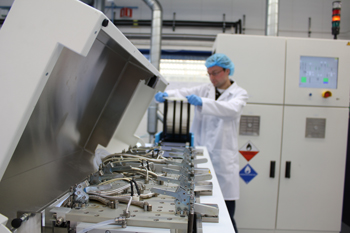Imec, RENA and SoLayTec are presenting a novel atomic layer deposition (ALD) passivation technology for highly efficient i-PERC silicon solar cells at the 27th European Photovoltaic Solar Energy Conference and Exhibition (EUPVSEC).

SoLayTec InPassion LAB (PDT) tool for deposition of spatial ALD Al2O3
The large area i-PERC solar cells measure156x156 mm and have a thickness of 165 µm. They demonstrate an efficiency of19.6% through an industrial screen printing process flow without selective emitters.
The manufacturing process for the solar cell was conducted in imec’s solar cell pilot line. It employed SoLayTec’s in-line spatial ALD process development tool, called InPassion LA, for deposition of ALD-Al2O3, and RENA in-line lab equipment for emitter removal and back-side polishing process. For the best cell, using the imec’s i-PERC process flow, an open circuit voltage Voc of 665 mV with 19.6% conversion efficiency was achieved. Spatial ALD-Al2O3 was found to offer excellent passivation without being affected by front-side parasitic deposition. The high level of passivation will enable better efficiencies. Dr. Aude Rothschild, senior scientist at imec, stated that the researchers were targeting an efficiency of more than 20%.
The results of the manufacturing process were derived using the silicon solar cell industrial affiliation program from imec. This program aims to develop sophisticated process technologies that lead to higher cell efficiency and lower silicon usage, which will lead to lower cost per Watt peak.
The results of the cell reveal the strengths of RENA’s InOxSide for junction isolation and InPolish equipment for rear-side polishing.
Disclaimer: The views expressed here are those of the author expressed in their private capacity and do not necessarily represent the views of AZoM.com Limited T/A AZoNetwork the owner and operator of this website. This disclaimer forms part of the Terms and conditions of use of this website.